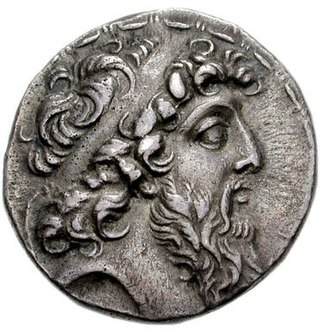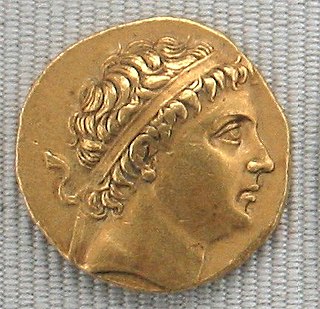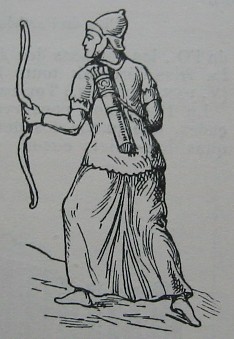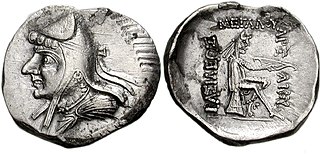Related Research Articles

The Seleucid Empire was a Greek state in West Asia during the Hellenistic period. It was founded in 312 BC by the Macedonian general Seleucus I Nicator, following the division of the Macedonian Empire founded by Alexander the Great, and ruled by the Seleucid dynasty until its annexation by the Roman Republic under Pompey in 63 BC.
Year 209 BC was a year of the pre-Julian Roman calendar. At the time it was known as the Year of the Consulship of Verrucosus and Flaccus. The denomination 209 BC for this year has been used since the early medieval period, when the Anno Domini calendar era became the prevalent method in Europe for naming years.

Demetrius II, called Nicator, was one of the sons of Demetrius I Soter. His mother may have been Laodice V, as was the case with his brother Antiochus VII Sidetes. Demetrius ruled the Seleucid Empire for two periods, separated by a number of years of captivity in Hyrcania in Parthia, first from September 145 BC to July/August 138 BC, and again from 129 BC until his death in 125 BC. His brother Antiochus VII ruled the Seleucid Empire in the interim between his two reigns.

Seleucus II Callinicus Pogon, was a ruler of the Hellenistic Seleucid Empire, who reigned from 246 BC to 225 BC. Faced with multiple enemies on various fronts, and not always successful militarily, his reign was a time of great turmoil and fragmentation for the Seleucid Empire, before its eventual restoration under his second son and eventual successor, Antiochus III.

Antiochus III the Great was a Greek Hellenistic king and the 6th ruler of the Seleucid Empire, reigning from 223 to 187 BC. He ruled over the region of Syria and large parts of the rest of West Asia towards the end of the 3rd century BC. Rising to the throne at the age of eighteen in April/June 223 BC, his early campaigns against the Ptolemaic Kingdom were unsuccessful, but in the following years Antiochus gained several military victories and substantially expanded the empire's territory. His traditional designation, the Great, reflects an epithet he assumed. He also assumed the title Basileus Megas, the traditional title of the Persian kings. A militarily active ruler, Antiochus restored much of the territory of the Seleucid Empire, before suffering a serious setback, towards the end of his reign, in his war against Rome.

Diodotus I Soter was the first Hellenistic king of Bactria. Diodotus was initially satrap of Bactria, but became independent of the Seleucid empire around 255 BC, establishing the Greco-Bactrian Kingdom. In about 250 BC, Diodotus repelled a Parthian invasion of Bactria by Arsaces. He minted an extensive coinage and administered a powerful and prosperous new kingdom. He died around 235 BC and was succeeded by his son Diodotus II.

Arsaces I was the first king of Parthia, ruling from 247 BC to 217 BC, as well as the founder and eponym of the Arsacid dynasty of Parthia. The leader of the Parni, one of the three tribes of the Dahae confederacy, Arsaces founded his dynasty in the mid-3rd century BC when he conquered the satrapy of Parthia from Andragoras, who had rebelled against the Seleucid Empire. He spent the rest of his reign consolidating his rule in the region, and successfully stopped the Seleucid efforts to reconquer Parthia. Due to Arsaces' achievements, he became a popular figure amongst the Arsacid monarchs, who used his name as a royal honorific. By the time of his death, Arsaces had laid the foundations of a strong state, which would eventually transform into an empire under his great-grandnephew, Mithridates I, who assumed the ancient Near Eastern royal title of King of Kings. Arsaces was succeeded by his son Arsaces II.

The Parni, Aparni or Parnians were an East Iranian people who lived around the Ochus (Tejen) River, southeast of the Caspian Sea. It is believed that their original homeland may have been what is now southern Russia, from where they emigrated with other Scythian tribes. The Parni were one of the three tribes of the Dahae confederacy.

Hyrcania is a historical region composed of the land south-east of the Caspian Sea in modern-day Iran and Turkmenistan, bound in the south by the Alborz mountain range and the Kopet Dag in the east.

Mithridates I, also known as Mithridates I the Great, was king of the Parthian Empire from 165 BC to 132 BC. During his reign, Parthia was transformed from a small kingdom into a major political power in the Ancient East as a result of his conquests. He first conquered Aria, Margiana and western Bactria from the Greco-Bactrians sometime in 163–155 BC, and then waged war with the Seleucid Empire, conquering Media and Atropatene in 148/7 BC. In 141 BC, he conquered Babylonia and held an official investiture ceremony in Seleucia. The kingdoms of Elymais and Characene shortly afterwards became Parthian vassals. In c. 140 BC, while Mithridates was fighting the nomadic Saka in the east, the Seleucid king Demetrius II Nicator attempted to regain the lost territories; initially successful, he was defeated and captured in 138 BC, and shortly afterwards sent to one of Mithridates I's palaces in Hyrcania. Mithridates I then punished Elymais for aiding Demetrius, and made Persis a Parthian vassal.

Diodotus II Theos was the son and successor of Diodotus I Soter, who rebelled against the Seleucid empire, establishing the Graeco-Bactrian Kingdom. Diodotus II probably ruled alongside his father as co-regent, before succeeding him as sole king around 235 BC. He prevented Seleucid efforts to reincorporate Bactria back into the empire, by allying with the Parthians against them. He was murdered around 225 BC by Euthydemus I, who succeeded him as king.

Phraates II was king of the Parthian Empire from 132 BC to 127 BC. He was the son and successor of Mithridates I.

Phraates I was king of the Arsacid dynasty from 170/168 BC to 165/64 BC. He subdued the Mardians, conquered their territory in the Alborz mountains, and reclaimed Hyrcania from the Seleucid Empire. He died in 165/64 BC, and was succeeded by his brother Mithridates I, whom he had appointed his heir.

Arsaces II, was the Arsacid king of Parthia from 217 BC to 191 BC.
The Battle of Ecbatana was fought in 129 BC between the Seleucids led by Antiochus VII Sidetes and the Parthians led by Phraates II, and marked the final attempt on the part of the Seleucids to regain their power in the east against the Parthians. After their defeat, the territory of the Seleucids was limited to the area of Syria.

The Parthian Empire, also known as the Arsacid Empire, was a major Iranian political and cultural power centered in ancient Iran from 247 BC to 224 AD. Its latter name comes from its founder, Arsaces I, who led the Parni tribe in conquering the region of Parthia in Iran's northeast, then a satrapy (province) under Andragoras, who was rebelling against the Seleucid Empire.

Andragoras was an Iranian satrap of the Seleucid provinces of Parthia and Hyrcania under the Seleucid rulers Antiochus I Soter and Antiochus II Theos. He later revolted against his overlords, ruling independently from 245 BC till his death.

Parthia is a historical region located in northeastern Greater Iran. It was conquered and subjugated by the empire of the Medes during the 7th century BC, was incorporated into the subsequent Achaemenid Empire under Cyrus the Great in the 6th century BC, and formed part of the Hellenistic Seleucid Empire after the 4th-century BC conquests of Alexander the Great. The region later served as the political and cultural base of the Eastern Iranian Parni people and Arsacid dynasty, rulers of the Parthian Empire. The Sasanian Empire, the last state of pre-Islamic Iran, also held the region and maintained the seven Parthian clans as part of their feudal aristocracy.

The Seleucid–Parthian Wars were a series of conflicts between the Seleucid Empire and the Parthian Empire which resulted in the ultimate expulsion of the Seleucids from the Iranian Plateau and the surrounding regions. The wars were caused by the mass migration of the nomadic Iranian Parni tribe into Parthia and the establishment of the Parthian state, which challenged Seleucid hegemony.

In 245 BC, Andragoras, the Seleucid governor (satrap) of Parthia proclaimed independence from the Seleucids, when - following the death of Antiochus II - Ptolemy III seized control of the Seleucid capital at Antioch, and "so left the future of the Seleucid dynasty for a moment in question."
References
- ↑ Montagu, John Drogo (2015-01-19). Battles of The Greek and Roman Worlds: A Chronological Compendium of 667 Battles to 31 BC From the Historians of the Ancient World. Frontline Books. ISBN 978-1-4738-9687-1.
- ↑ "Polybius, Histories, book 10, Antiochus the Great In Media". www.perseus.tufts.edu. Retrieved 2020-09-27.
- ↑ Overtoom, Nikolaus Leo (2020-05-11). Reign of Arrows: The Rise of the Parthian Empire in the Hellenistic Middle East. Oxford University Press. ISBN 978-0-19-088834-3.
- ↑ "Polybius, Histories, book 10, Antiochus Moves into Hyrcania". www.perseus.tufts.edu. Retrieved 2020-09-27.
- ↑ "Polybius, Histories, book 10, Fighting On Mount Labus". www.perseus.tufts.edu. Retrieved 2020-09-27.
- ↑ "Polybius, Histories, book 10, Antiochus Reaches Tambrax". www.perseus.tufts.edu. Retrieved 2020-09-27.